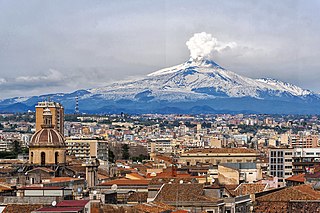
Catania is the second-largest municipality in Sicily, after Palermo, both by area and by population. Despite its reputation as the second city of the island, Catania is the largest Sicilian conurbation, and among the largest in Italy. It has important road and rail transport infrastructures, and hosts the main airport in Sicily. The city is located on Sicily's east coast, facing the Ionian Sea at the base of the active volcano Mount Etna. It is the capital of the 58-municipality region known as the Metropolitan City of Catania, which is the seventh-largest metropolitan area in Italy. The population of the city proper is 311,584, while the population of the Metropolitan City of Catania is 1,107,702.
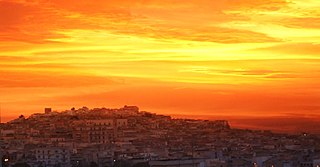
Canosa di Puglia, generally known simply as Canosa, is a town and comune in the province of Barletta-Andria-Trani, Apulia, southern Italy. It is located between Bari and Foggia, on the northwestern edge of the plateau of the Murgia which dominates the Ofanto valley and the extensive plains of Tavoliere delle Puglie, ranging from Mount Vulture at the Gargano, to the Adriatic coast. Canosa, the Roman Canusium, is considered the principal archaeological center of Apulia, and is one of the oldest continually inhabited cities in Italy. A number of vases and other archaeological finds are located in local museums and private collections. It is not far from the position on the Ofanto River where the Romans found refuge after the defeat of the Battle of Cannae and is the burial place of Bohemund I of Antioch.

GiacomoBarozzida Vignola, often simply called Vignola, was one of the great Italian architects of 16th century Mannerism. His two great masterpieces are the Villa Farnese at Caprarola and the Jesuits' Church of the Gesù in Rome. The three architects who spread the Italian Renaissance style throughout Western Europe are Vignola, Serlio and Palladio. He is often considered the most important architect in Rome in the Mannerist era.

Valle San Giovanni is a small village in the province of Teramo, in the Abruzzo region of central Italy. It is a frazione of the town of Teramo.

The province of Teramo is a province in the Abruzzo region of Italy. Its capital is the city of Teramo. The province has an area of 1,948 square kilometres (752 sq mi), a population of 313,029 (2012), and is subdivided into 47 comuni, see comunes of the province of Teramo. The province of Teramo shares its northern border with the province of Ascoli Piceno in the Marche region, southern and southwestern borders with the province of L'Aquila in the Abruzzo region, and a western border with the province of Rieti in the Lazio region. To the south is the province of Pescara in the Abruzzo region and to the east is the Adriatic Sea.

Teramo is a city and comune in the Italian region of Abruzzo, the capital of the province of Teramo.

Alatri is an Italian town and comune of the province of Frosinone in the region of Lazio, with c. 30,000 inhabitants. An ancient city of the Hernici, it is known for its megalithic acropolis.

Civita di Bagnoregio is an outlying village of the comune (municipality) of Bagnoregio in the Province of Viterbo in central Italy. It lies 1 kilometre (0.6 mi) east of the town of Bagnoregio and about 120 kilometres (75 mi) north of Rome.
Martone is a comune in the province of Reggio Calabria, Calabria, in the south of Italy. It originated in the 7th and 8th centuries. The comune was founded by Greek monks from the Byzantine Orient who travelled from regions of the Aegean-Levantine to escape Syrian persecution.
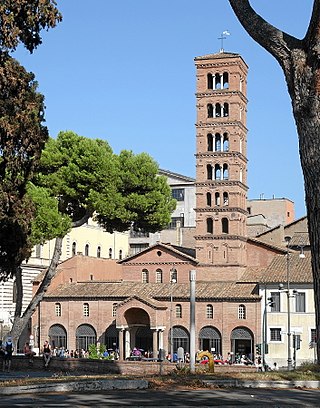
The Basilica of Saint Mary in Cosmedin is a minor basilican church in Rome, Italy, dedicated to the Virgin Mary. It is located in the rione (neighborhood) of Ripa. Constructed first in the sixth century as a diaconia (deaconry) in an area of the city populated by Greek immigrants, it celebrated Eastern rites and currently serves the Melkite Greek Catholic community of Rome. The church was expanded in the eighth century and renovated in the twelfth century, when a campanile was added. A Baroque facade and interior refurbishment of 1718 were removed in 1894–1899; the exterior was restored to twelfth-century form, while the architecture of the interior recalls the eighth century with twelfth-century furnishings. The narthex of the church contains the famous Bocca della Verità sculpture.
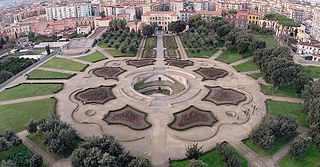
San Giorgio a Cremano is a primarily residential town and comune in the Metropolitan City of Naples, in Italy. It is located on the foothills of Mount Vesuvius to the west of the volcano and the sea, and is five kilometres to the south east of the centre of Naples. Most parts of the municipality command views of Mount Vesuvius, Mount Somma and the Bay of Naples.

There are more than 930 churches in Rome, which makes it the city with the largest number of churches in the world. Almost all of these are Catholic.

Montorio al Vomano is a town and comune in the province of Teramo, in the Abruzzo region of central-southern Italy. It is located in the natural park known as the Gran Sasso e Monti della Laga National Park.

Crognaleto is a comune and city of slightly less than 2,000 people in the Province of Teramo, central Italy. Crognaleto sits at an elevation of 1,105 metres (3,625 ft) and has its communal administrative offices in the frazione of Nerito. The commune of Crognaleto sits on the slopes of the Monti della Laga mountain range and extends across both the northern and the southern slopes of the Vomano Valley. It lies within the Gran Sasso e Monti della Laga National Park.
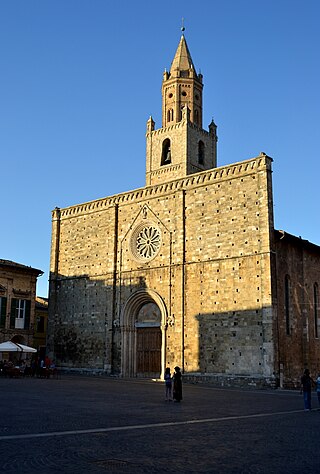
Atri is a comune in the Province of Teramo in the Abruzzo region of Italy. Atri is the setting of the poem The Bell of Atri by American writer Henry Wadsworth Longfellow. Its name is the origin of the name of the Emperor Hadrian, whose family came from the town.
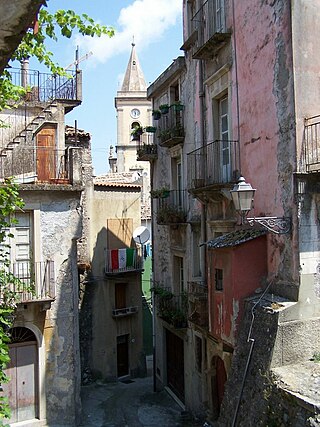
Novara di Sicilia is a comune (municipality) in the Metropolitan City of Messina in the Italian region of Sicily, located about 160 kilometres (99 mi) east of Palermo and some 40 kilometres (25 mi) southwest of Messina.

Collevecchio is a small village in the Abruzzo region of Italy. It is a frazione of the comune of Montorio al Vomano.

The Gran Sasso and Monti della Laga National Park is a natural park in central Italy. Established in 1991, it covers an area of 2,014 square kilometres (778 sq mi), mostly within the provinces of Teramo, L'Aquila, and Pescara in Abruzzo, with small areas in the provinces of Rieti in Lazio and Ascoli Piceno in Marche. The terrain is predominantly mountainous with alpine plains.

Spiano is a frazione of the commune of Teramo in the Abruzzo Region of Italy. It sits about seven miles from Teramo on a hill that overlooks both the Tordino and the Vomano valleys.

José D'Andrea Valeri known as "Padre Odorico D'Andrea", was an Italo-Nicaraguan Catholic priest. He founded the Franciscan Sisters Pilgrims of the Immaculate Heart of Mary, along with Father Francisco Javier Munguía Alvarado, also a Franciscan. He was a missionary of the Order of Friars Minor or Franciscans, devoted to the mission in the communities of the City of San Rafael del Norte in the department of Jinotega, Nicaragua.



















